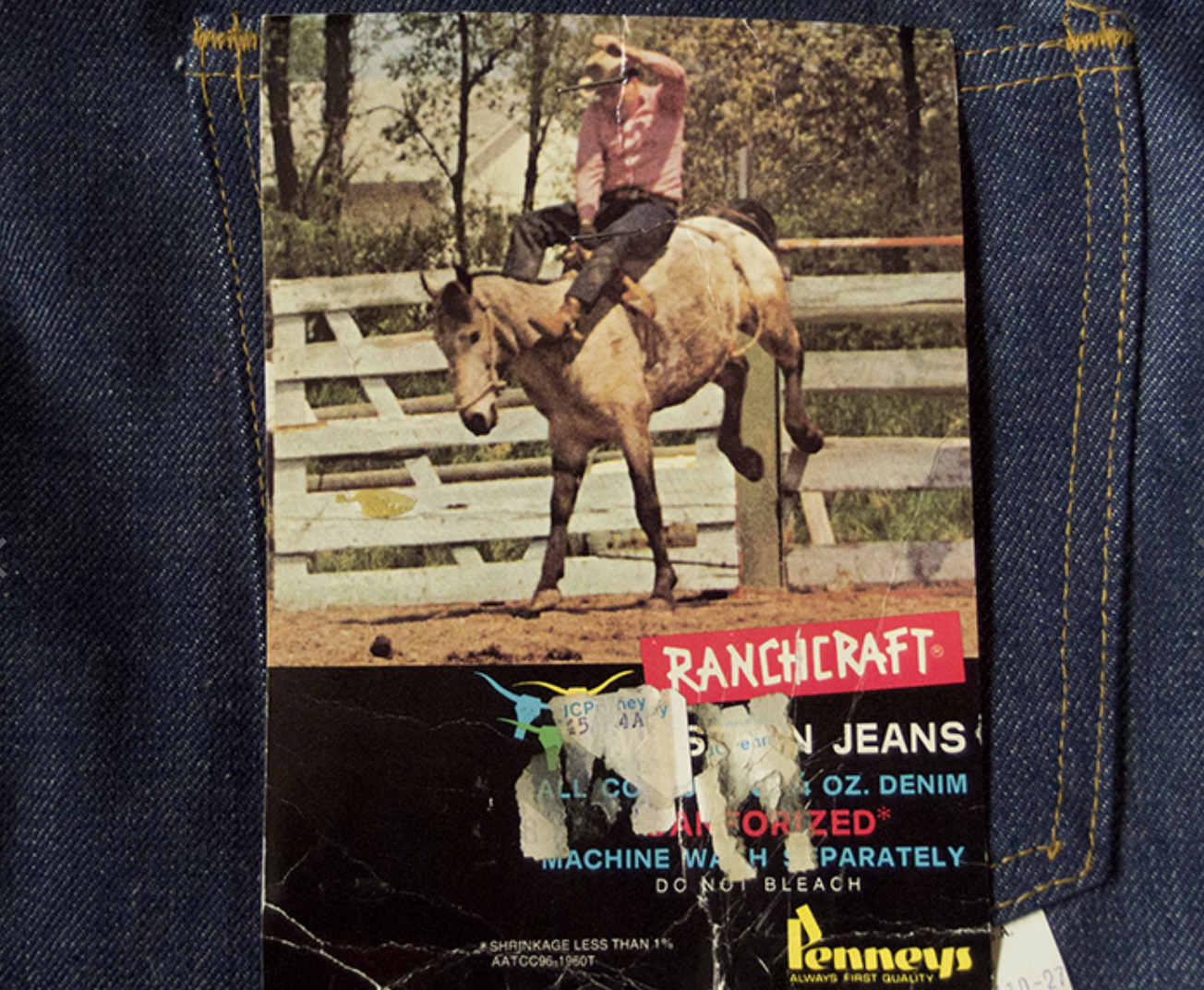Department Store Cowboy: Three Ranchcraft Picks
Old Ranchcraft tag on a pair of pants. (Credits: denimarchieves.com)
All fans of western shirts have already seen the name of this brand: Ranchcraft. But the first thing to know is that Ranchcraft was actually a sub-brand created by the giant JC Penney. And it was a way for the company to reach a new audience.
How did JCPenney break into the world of Western wear? The earliest use of their Ranchcraft trademark dates to 1946. However, finding pieces from before the 1960s proves difficult (but not impossible).
It appears that during these formative years, they produced women’s jeans and men’s shirts among a select few other garments. In the later decade, Penney saddled up and took their western wear line to greener pastures.
A pristine pair of 1950s women’s jeans carry the Ranchcraft brand. (Credits: ©Raleigh Vintage.)
Advertising and technology
Before the internet, the battle for consumers was waged in print advertising and won on the sales floor. This is how department stores—with highly polished displays and painstakingly organized shelves—achieved dominance.
Thus, JCPenney not only carried a western wear brand, they opened an entire department. This was the case at five stores in the United States. Appropriately, all five of these locations were west of the Mississippi River.
This advertisement dates anywhere from 1963 to 1971 based on the logo. (Credits: ©CyperusPapyrus / eBay.)
The tag on many 1960s Ranchcraft shirts and jackets proudly advertises “Penn-Prest.” JCPenney trademarked this phrase for a version of wrinkle-free fabric.
The company was very proud of this technology because it debuted with many of its homegrown brands. An industry publication from 1966 lists Penn-Prest for everything including, “...permanently pressed slacks, shirts, maternity wear, boys’ dress suits, and girls’ dresses and slips.”
Well, nobody liked wrinkly Western wear either.
Permanently creased jeans. Does it get any more ‘60s than that? (Credits: ©RetroRise1/Etsy.)
Three garments we love
Besides a lack of wrinkles, there are plenty of other features that make Ranchcraft a solid staple for collectors. Below is a sampling of some of our favorites.
1. Denim jacket
It's autumn. We may as well look at one of the essentials for fall wardrobes—western wear or otherwise. Penney's spin on versatile denim has a variety of pockets. With the originals that I've seen, the Ranchcraft patterns typically have patch pockets, with pocket flaps, on the chest and welt pocket openings at the waist with interior patches. The latter is surrounded by topstitching that’s both functional and decorative. In keeping with the times, the absence of a back buckle is typical. These jackets could be lined for warmth or unlined for a more all-season appeal.
A lined sherpa variant of a classic. (Credits: ©StCyrVintage/Etsy).
2. Jeans
Compared to the jacket above, this approach to jeans is fairly conservative. Even the rivets are plain and devoid of any ornamental stamping. A nice, sanforized 13-¾ ounce denim is heavy but retains a soft(ish) hand. Simply put, these are a dependable pair of pants that wouldn’t be out of place even 60 years later.
Pair of pants. (Credits: ©Denim Archives)
3. Shirt
This is just a beautiful shirt with all the trappings that you’d expect. We’ve seen several Ranchcraft shirts cut from this same pattern, albeit with different tags, and they’re all equally as vibrant. Like the jeans above, nothing here is over the top stylistically.
The top tag likely predates the first use date of the “Penn-Presst” trademark, 1964. (Credits: ©SparrowsAndWolves/Etsy.)
The 1960s produced some incredible fashion. Perhaps more than any other decade in the 20th century, it was marked by drastic changes–a shift from the more classic forms of dress to the ultra-casual. Like the perennial flowers on a paisley shirt, some styles come and go.
Western wear is no exception : Ranchcraft and JCPenney hit their stride in the 1960s and ‘70s. “Cowboy Core” rode a twenty-year-high with the popularity of westerns on television and the big screen.
Western style would fade a bit in the following decades, but it has remained an enduring part of American fashion in many circles. Now, it’s coming back big time. Collectors have renewed their interest in western wear in recent years, and some of the lesser-known brands are shedding dust and returning to our wardrobes
To learn more about Heritage Style, craftsmanship and menswear fashion, browse our library of anthologies.










